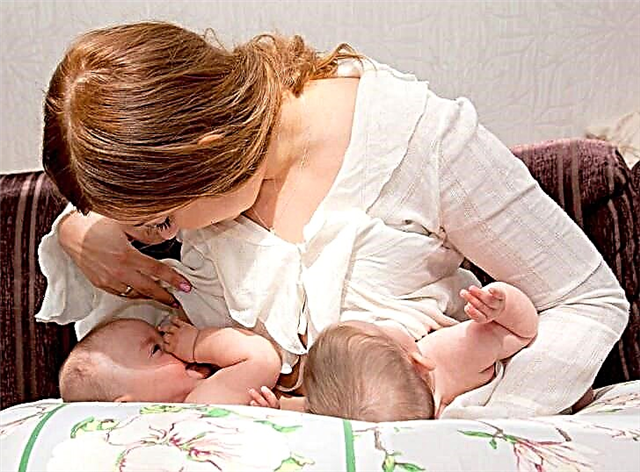Time flies by. Most recently, your little one was born, you carried a small lump on your hands. Now you can't recognize him: the baby has changed dramatically in appearance, he knows a lot and understands. The development of a child at 12 months is even more focused on learning about the world around him. This period is a transitional one, therefore, to some extent it is difficult for the crumbs and parents.

What's new in the physical development of a one-year-old child
At 12 months, the baby weighs 9.5 - 10.5 kg (± 1 kg) and height 74 - 76 kg (± 3 cm). The gain in weight and growth does not differ significantly from the previous month.
What's new in your little one at twelve months
- Goes by the handle or independently. But he can continue to actively crawl on all fours.
- A child at 12 months old can take two small objects with one pen, and three or a handful with two.
- Confidently hands the object to an adult and releases it. Knows how to grab a button on your clothing with your bent thumb and forefinger.
- Can squat or sit unsupported.
- Knows how to build a turret from several cubes and put rings on a stick.
- He continues to master gestures, except for those that have already been mastered (see a child at 10 and 11 months), he can still: send a kiss (if you teach him), kiss his mother, blowing hot.
- At 12 months, the child makes attempts to eat with a spoon on his own, provided that you show it to him and allow him to do it himself.
We read in detail: what can a child at 1 year
What's new in psychological development
- By the age of one, a child understands more than 20 words and knows the names of objects that he sees around him every day. The pronunciation of words is still vaguely reminiscent of the proper, syllables can be rearranged, not all letters are pronounced. Toddlers put several meanings into one word;
- A child at 12 months old begins to reach out to other children, but so far he cannot communicate without conflicts;
- Now the baby understands well how and with whom in the family you can behave. He feels the softness of his mother and allows himself to be naughty or even manipulate her. Knows that this will not work with dad;
- By the age of 12 months, it becomes more and more difficult to play with a child, he can establish some of his own rules in games that are not acceptable to you and persist in what cannot be done: throwing sand, pulling the cat's tail;
- Children from about this age begin to show long-term memory. Toddlers can remember what happened yesterday or a few days ago. There are people who, as adults, are able to remember themselves at one year old;
- When a child listens to music, he tries to sing along, and while standing, he tries to dance;
- Fulfills simple requests (see child at 11 months.);
- Approximately, starting from the 9th month, but most often in one year, children may experience a difficult transitional moment when they become seemingly different from themselves and radically change - this is the crisis of the first year. How does it manifest itself:
- Disobedience, stubbornness;
- A sharp increase in independence (refusal to help);
- Touchiness and tearfulness;
- Contradictory behavior (the child may get annoyed when something does not work out and wait for help from you, but immediately refuse it).
Any mother has questions: why did the child begin to behave this way? What is it: harm or have I spoiled him? Do not worry too much and react violently to changes. Here are the reasons why your baby's behavior changes:
- The child gradually develops a will, which increasingly begins to collide with the will of an adult, which causes a protest from the child;
- The world perception of a child from 12 months completely changes: he realizes the first signs that he is a separate person, that parents are adults who are allowed more than him;
- With the acquisition of more and more skills, the child grows self-confidence, and he becomes more and more independent. At the same time, the baby cannot yet adequately assess its capabilities, distribute power, and foresee the situation. Therefore, the child, as it were, overestimates himself and because of this suffers failures, which, of course, infuriate him. The child cannot accept the thought: “that he cannot do what he wants, because his mother can do it”;
- Prohibitions are perceived by the child as an obstacle for adults to cognize the world.
Child development test at 12 months
- The child should already be able to crawl, stand with support and take a few steps if you are holding him by the arms;
- At 12 months, he must use 1 - 2 gestures: wave a pen, nod "yes" or "no";
- Must say at least one meaningful word: mom, dad;
- Should be able to fulfill simple requests: give, take;
- In addition, skills acquired in previous months should be present (see child at 10 and 11 months);
- By the end of the first year, the child should have at least one tooth or a swollen gum - evidence that the tooth is growing.
If at least one of the test points is negative, then you must definitely visit a pediatrician.
Video: Child development by months. 1 year / 12 months
Mode: sleep and food
Parents of many one-year-olds are faced with a regime change. We have to do this because now it becomes difficult for the child to lie down at the same time during the day, so daytime sleep has to be pushed aside. This is how the "owls" manifest themselves, waking up in the morning at 9 - 10 o'clock, and in the daytime at 14 - 15 o'clock. Thus, it turns out that such children begin to sleep once during the day for 2 - 3 hours, from about 14 to 17 hours, and their night sleep begins only at 22 hours or even later.
In this regard, it is necessary to accustom the baby to a different diet. If the child goes to one long daytime nap, then five times it will not work. Such kids eat 4 times, for example: breakfast at 9.00, at 13.00 - lunch, at 17.00 - afternoon tea and dinner at 21.00.
If your baby's routine has not changed, then everything remains the same. (see baby at 11 months)
How to help your child develop

- Continue to carry your baby periodically. "Holding" a child at 10 months);
- The development of a child at one year is still aimed at improving speech and fine motor skills, so continue activities that develop these functions. child at 10 and 11 months);
- The most important skill that your baby is now acquiring is walking. As much as you want your child to start walking, it is important that he is ready for it. If the baby has mastered crawling and moves with ease, then you can push him to start walking, but you do not need to wean him from crawling. For this:
- Place your baby's favorite toys at an accessible height. As soon as you notice that the child stands up and reaches for the object, move it a little further away from him so that the baby can take a few steps towards the target. Do not rush the baby, the musculoskeletal system is gradually getting used to new loads. Increase the distance gradually;
- When your child learns to take a few steps on his own from support to support, create several such goals for him in the form of toys. Let the baby move from one support to another: from chair to crib, from crib to chair;
- Very often, a feeling of insecurity and fear of losing balance prevents the baby from taking the first step. Give him a balance toy, step back a couple of steps and ask him to bring you an object. This is enough for many children to dare to walk on their own;
- When you go for a walk with your child, pay his attention to other children who are already walking. Someone else's example is contagious;
- Do not overuse the walker, they can form incorrect posture (PROS and CONS). Better to use rolling toys or reins. Support your baby by the forearms or hands, but not by the armpits. When the baby is able to take several steps on its own, you can belay from behind, supporting it by the hood. Now try to use the stroller less;
- Falls are an important part of learning to walk. Do not rush to him immediately after falling, let the baby try to get up himself. Help if the child really cannot get up or bumped and cried;
- If you have somewhere to walk on the grass, on the sand or just on the ground, then it will be useful to let the child walk barefoot. On a hard floor, you need to teach a baby to walk only in special children's shoes. The reason is that when walking, certain muscle groups are strained in the foot, which occurs only when moving along natural surfaces (earth, sand, stones). When a child walks on a hard floor, the foot is relaxed or not fully tense, which leads to various disturbances in the gait and ankle. It should be noted that the first shoes should be not just slippers or smart sandals, but orthopedically correct shoes. It is desirable that they be laced up and with a high back - for a stable fixation of the ankle and with a 5 mm heel - for the prevention of flat feet. Of course, you don't need to keep the child in boots all the time, but when the baby learns to walk, put it on.

Games
Play story games with children: everything that you saw during a walk can be played at home with toys, for example: you watched a truck unload a body. At home, you can repeat this with a children's toy car and cubes. Or arrange fairy tales for your child with the help of a finger theater for children or matryoshka dolls in the form of fairy tale heroes.
It's time to rebuild your relationship with your child. Organize your games and activities with him so that they go together, but at the same time, you allow the baby to independently do what he can do. There should be sincere trust between you and the child, only in this case the baby will be able to learn from you and fully develop.
← 11 month
Video: 1 year, development, regime, common table
Child development calendar by months (choose a month)












General article: Development calendar from birth to one year (all 12 months)



